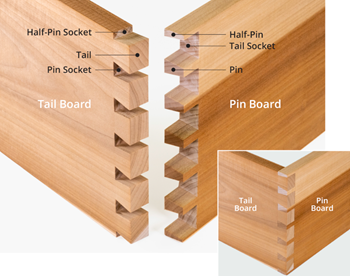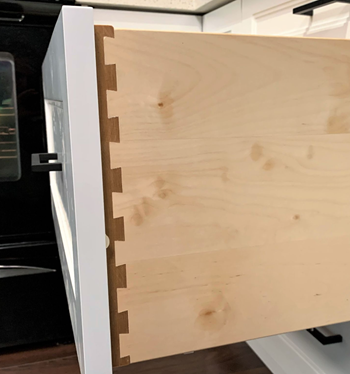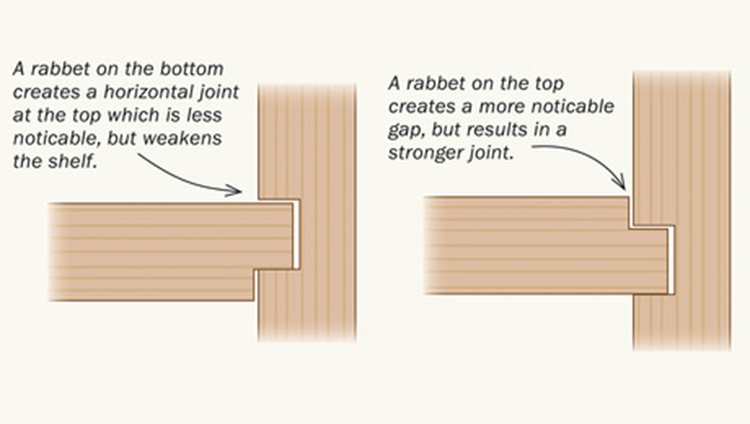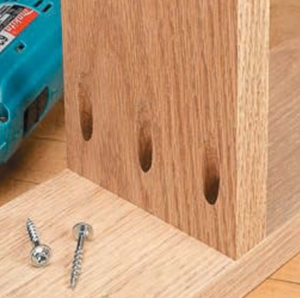When it comes to cabinet making, different types of cabinet drawer joints can make a difference in how study and therefore lasting your cabinets will be. In this blog post, we'll look at some of the most common joint types used by cabinetmakers. We'll also discuss the benefits and drawbacks of each joint. So, if you're interested in learning more about cabinet making joints, read on!
Dovetail Cabinet Drawers
At the heart of every well-made cabinet drawer lies a

strong and reliable dovetail joint. Expertly crafted using precise angles and carefully selected pieces of wood, dovetail joints ensure that your cabinet drawers are durable and long-lasting.
Dovetail drawers are a popular choice for cabinetry due to their elegant design and sturdy construction. Crafted with strong interlocking joints, these drawers are uniquely able to hold up under heavy loads without sagging or buckling. Dovetail joints are often used for cabinet drawers and then the cabinet drawer face is adhered to the tail board using good quality nickel alloy wood screws.

In addition to being aesthetically pleasing and highly functional, dovetailed drawers offer a wide range of customization options. It is not uncommon for us to suggest slightly darker tail boards or to even stain the tail boards to give off that contrasting appearance when the drawers are open.
We love the soft close drawer slide effect and often specify that type of drawer cabinet hardware without you having to say anything. The actual hardware is hidden from view but you know it is working well when you don’t hear any friction and appears the drawer floats on air. So, if you're interested in high quality kitchen cabinetry, we recommend you go beyond the pretty appearance and make a few suggestions on how your cabinets are constructed with your
local kitchen cabinet maker in NJ. Sturdy construction of kitchen cabinet drawers should call for dovetail joints. Then ask your custom cabinet designers for soft close slide hardware that will stand the test of time. Don’t forget to specify the drawer pulls too. Leave nothing for chance.
Types of Wood Joints for Kitchen Cabinets
Dado Joints for Cabinet Boxes

Most consumers would not consider discussing the types of wood joints your cabinetmakers plan on using when making your set of custom kitchen cabinets. We at Tobias Design do take that dive into actual construction techniques when we order your cabinets. We have been specifying details for our customers for over 20 years and have learned that we should “be aware”. A common wood joint used for kitchen cabinet boxes is the dado joint. We have learned that the actual position of the “Rabbet”, part of the dado joint. When the rabbet is positioned at the top of the joint, it results in a stronger structure. We can always seal the gaps that appear with joint filler and often we are painting over the joints, so no gaps are really visible.
A stopped dado involves cutting a groove at one end of a piece of wood while leaving the other end intact. These dado joints provide benefits that make them ideal for many cabinet making applications. They allow pieces to be connected securely without fasteners, resulting in strong and aesthetically pleasing joints.
Pocket Hole Joints
Pocket joints are created by cutting out a hole or

pocket in one piece of wood and then fitting another piece into the hole. This technique is commonly used in the construction of drawers and doors, as well as boxes, chests, and other objects that require multiple parts to be fitted together. The strength of pocket joints lies in their simplicity and flexibility.
They can easily accommodate uneven edges or mismatched shapes and are simple enough for even novice woodworkers to create. In addition, because pocket joints use only two pieces of wood rather than several, they often result in a more streamlined look. Overall, this joint offers a range of practical benefits and aesthetic advantages, making it a popular choice among builders and DIY enthusiasts.
Tongue and Groove
Tongue and groove joints are created by interlocking two pieces of wood along their edges. This joint is generally used to construct floors and walls, and rarely used in the construction of kitchen cabinets. The only occasion we have had the opportunity was for a mountain house when our customer insisted upon some exotic wood flooring to face a wall of cabinets. The project came out nice, but it was too labor intensive for us to consider doing this again.
When to Use Tight Fitting or Loose Fitting Joints
For example, loose tongue and grooves might be preferred in damp environments or high-traffic areas, as they allow for greater flexibility. Conversely, tight-fitting joints may be more suitable when precision and exact alignment are critical to the project's success. Ultimately, the choice between loose or tight joins will depend on various factors, including the desired strength and appearance of the finished product. However, regardless of which tongue and groove joint are selected, one thing is clear: this simple yet reliable construction technique has played an essential role in countless building projects for hundreds of years.
Kitchen Cabinet Designers Ready to Join the Conversation
Now that we've explored the different types of joints used by cabinetmakers, you may better understand which is best for your project. If you still need clarification or help in choosing the right specifications for your
custom kitchen cabinet designs, we would love to design your cabinets for you. It all starts with a phone call to discuss your desires and vision.